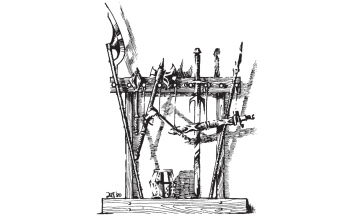
This morning I took another pass at my D&D/Warhammer mash-up Ten Dead Rats, updating it to draft 2. The link in the original post has been updated, and is included below as well. I’ve also created a character sheet, which you can download here as either a form-fillable PDF, or a PNG image optimized for printing. Before we get into analysis, here are the links:
Ten Dead Rats – Second Draft
Ten Dead Rats Form Fillable PDF Character Sheet
Ten Dead Rats Printable PNG Character Sheet
Besides some formatting edits and language clarification, the big thing I tinkered with in draft 2 is XP. It’s still largely theoretical and could certainly use external feedback and play-testing. I chose to have a single unified XP-per-level chart ala 5e, and loosely based it on the fighter XP chart from OD&D. I smoothed the formula to a simple doubling per level, and cut the numbers by a factor of 10 to both be easier to deal with and scale better with the low wealth economy I’d expect in Warhammer.
All that said, I really wanted to steal some of the things I saw 4th edition Warhammer doing with XP – notably giving character creation awards to influence random rolling, and creating standard reward levels based on player-driven goals. To be honest, while I love XP for treasure in D&D, I wasn’t totally convinced it would work in Warhammer since I expect the players to be continuously poor, and I’d rather their actions be driven by self preservation and a misguided desire to “do good”, than pure money-hoarding greed (though some greed is certainly to be expected).
I toyed with the notion of ditching XP for treasure and instead making XP work purely by player-set goals, but then it kind of fights the geometric leveling progression. I found if I tried to scale the reward values based on party level, I was getting very close to 5e “milestone” leveling which just feels too much in the arena of GM fiat to me.
So I left the treasure XP in as standard, and then also wrote an option for doing purely goal-based leveling. I’m really not sure which I’d want to use, and may simply take this to a vote with my players when I start up a campaign. It may depend largely on what kind of characters they make.
Finally, I really needed to create a character sheet. Beyond the base utility at the table, I find having a character sheet available when reading rules really helps comprehension. For example, the derived characteristics in Ten Dead Rats (WS, BS, Move, AC, and Wounds) are a bit scatter-shot through the text. Seeing them all collected in one place on a character sheet I think helps firm up all the bits that make a character in your head.
For the layout of the character sheet I was eager to see if I could fit it all on a single half-page of paper. I think I succeeded, but I have a nagging feeling that I left something out. Also for some reason I couldn’t figure out what settings in Acrobat would let me print two side-by-side copies for manual entry with a pencil, hence the PNG version I’m also posting.
If anyone ends up playing with any of this stuff, or even just giving it a read, please do drop me a line and let me know what you think. After I’ve gotten to play a couple sessions of it for real I’ll do one more edit and pull off the “draft” moniker. I expect that to happen reasonably soon – more news to follow!



I had read the 1st draft and plan to give this a deeper look once I finish some year end/start projects.
First (2nd) Impressions, looking over the new draft.
I like how you use the Ability Score and Bonus and call out each as their own stat.
XP will for sure need some at the table testing. Accomplishing a goal that takes 6-12 sessions gets you half way to level 2. Curious how that works at higher levels. I will be interested to hear how your experience plays out. (tempted to knock level 5 down to 1500, then level 9 /10 to 25/50k.)
Also interested to see how the roll for spell plays.
In any event, Insanity Cards arrived yesterday!
Yeah, with the level multiplier the “percent to next level” drops as you level up. Is this a good thing? Maybe? Another thought struck me last night – what if instead of having a specific expected duration for goals, you just created a compounding reward based on how long the goal takes to achieve? Eg, 10 XP if you complete it in one session, 20 in two sessions, 40 in three sessions, etc. Maybe that gets out of hand, and maybe you want to tune it to something less than 2x every session, but I kind of like the notion of the longer it takes to reach a goal, the more significant the pay-off is.
The roll for spells is pretty close to how WFRP 2e does it, and Small But Vicious Dog pretty much uses that exact system. My main change was to drop it from d10 to d6, and then just use Delta’s Book of Spells for the spell list. The big question will be, did I get the numbers right in terms of difficulty to cast a spell vs risk of mishap?
Glad you got your insanity cards! Kind of disappointed it took so long for them to arrive – I guess the holidays put a crunch on everything.
Definitely going to check this out! One thing which jumped out at me from your previous post was the little incremental advancements mention. Have you read Five Torches Deep yet? Not that you need yet another game, I’m sure, 😀 , but I thought they did a nice elegant job of simplifying down the 5E advancement-every-level into an old school simplified four class structure (though with three “subclasses” under each allowing some greater variety starting at 3rd level).
Took a quick skim through the second draft and the only thing which jumped out at me for an edit was the Spell talent. As written a 4th level character should be able to learn & cast a 3rd level spell, and definitely would be, except that the example contradicts the rule. I think you need to just say half their level rounded up, not half their level +1.
“Spell – You learn an additional spell. You can take this Talent as many times
as you like. You cannot learn spells of a level higher than half your current
character level plus 1. Thus, a 5th level character can only learn spells of spell
levels 1, 2, or 3, while a 4th level character is limited to only spell levels 1 and
2.”
Yup, good catch. I’d also love a better name for this talent. “Spell” is accurate I suppose, but a bit dull sounding.
In fact, I just read it last night! I will likely be posting a review of my thoughts here on the blog very soon.
Excellent!
Yeah, “Spell” is a little dull, but descriptive. “Increased Arcane Lore” or something might be too vague. Maybe “Incantation”, or something?
I also think the doc might want a quick “leveling up” summary section. Just listing everything which you get when you level up in one place, instead of it being scattered. Looks like most of it is in the Class summary boxes, but I’m not 100% sure from the Class section whether the intent is for the characters to gain the indicated die plus TB every level? Or just the die once at 1st and only the TB increase every additional level?
I think characters get WS, BS, Wounds, and a Talent when they level up. And their Saves increase, though that’s really not a stat. Am I missing anything?
Not that I want to give you a lot of homework, but have you watched any of Dan DeFazio (Prof. Dungeonmaster)’s vids on YouTube? Dungeon Craft? He runs a very WH-inspired flavor of D&D, and one of the gritty elements he uses which I think really helps carry the lower fantasy setting is capping PC hit points, and of course lowering bad guy HP appropriately as well. I think he caps the PCs at 15 or 20. You don’t necessarily have to go that low, but I think it’s a really appropriate element. He also has a really simplified XP system, too. Basically a level every 10 xp, with awards all being in single digits. Of course, his are all plot-based or PC ambition-based, which also serves his setting intent of the PCs frequently being broke, which you indicated is one of your goals too.
Anyway, I don’t mean to just give criticism. On first pass, the doc looks great and reads very well, and I like the way you’ve boiled down classes, careers and talents. I still have my old 1st ed WHFR, but it never got much table time, and I could definitely see using your take.
Oh no, please don’t feel bad for critiquing. I asked for the feedback, please keep it coming!
I have not seen Dan DeFazio before, I’ll have to go look him up. I also find a lot of the Lamentations of the Flame Princess very much in line with the feel I prefer. I could see capping HP as a pretty good way of keeping things gritty. I also considered making my top level lower – maybe 7 or even 5. I was just a bit worried about running out of head room so I went up to 10, but in my imagination I would think it would take many years of play for a character to actually hit that.
A summary of what goes up on leveling is a great idea. You are correct that WS, BS, Wounds, and an extra Talent are what you get, and that like D&D each level is supposed to gain you one die plus TB Wounds to your total.
I’ll have to figure out where to squeeze that into the doc. The bookbinder in my says I need to keep my page count to a multiple of 4, so I may have to drop something. Actually, I was kind of considering dropping the monsters, or at least reducing it to just a conversion guide sans examples, so I could fit the character sheet in the main doc.
I suspect I may tinker with the XP system more. I’m really kind of enjoying this notion of compounding goal rewards. I just need to run some numbers and figure out how to summarize the idea elegantly.
A few quick notes (coming from someone who hasn’t read Small but Vicious Dog, so apologies if any of the ambiguities are clarified in there):
-(pg 13) It seems like there’s no reason to get a great weapon instead of a pole arm, since you’re paying double to do less damage with the same carrying weight??
-(pg 17) Unclear if spells are still cast when a mishap happens, i.e. would someone with 2+ magic dice always be able to cast a level 1 spell? I’d assume the spell still happens, otherwise having more than 2 magic dice would start to increase your chances of failing to cast a 1st level spell, which feels off (haven’t tried to think about how it’d affect higher level spells, admittedly).
-(pg 2/pg 17) The TN for a “difficult” test is undefined (example TNs on pg 2 show only “rather difficult”). I’d guess you meant it to be the same (i.e. TN 25), except the next sentence implies it’s a TN 20 test by giving a bonus for every 5 points above 20.
-(pg 17) Following on the previous point, if TN 25 is the intent, any successful surgery will cure at least 2 insanity points. Nothing wrong if that’s the intent; just pointing it out to make sure you meant it.
-(pg 18) You can drop the last sentence of the insanity section by prepending the previous paragraph with “Regardless of the Surgery test’s result, the patient must then…”. Nothing wrong with it as written, but it just jumped out as a chance to save some words 🙂
-(pg 10/pg 20) Disarming requires an opposed Agility test, but Agility is undefined for monsters. Maybe change Disarming to an AgB save to resist to avoid needing to make up an Agility stat for NPCs every time it comes up?
Nice, thanks so much for all the feedback! Here are some quick responses:
1. Yup, pole-arms are meant to be equivalent to the 2e halberd, which costs less and weighs less than a great weapon, and can act as either a great weapon or a spear. They’re just a better weapon all around. You should consider buying a halberd.
2. WFRP 2e had different rules for “all dice come up 1” and doubles. Conflating them into a single system does make it such that there’s little reason to choose 1 die over 2 if possible. Is that a problem? I’m not sure. I could possibly add back an extra clause of “if all the dice are 1, the spell fails regardless of TN”. Does that feel better?
3. Good catch, I’m just removing “difficult” from the text here. It’s just a regular Int test – 20 should remove 1 IP, 25 should remove 2 IP, etc.
4. Good edit on p. 18, I’m making that change.
5. Yeah, that’s a great catch. You may still have cases where you need to come up with stats like Ag for monsters, but we might as well eliminate this one and switching it to a save is a pretty elegant solution.
1. All good. Just wanted to point it out to make sure you hadn’t gotten the numbers flipped somewhere on accident. I’ve done that often enough in my own house rule write-ups 🙂
2. Ah, nevermind for my point about casting magic. Dice pool mechanics always get me on guard for being less obvious about punishing competence inadvertently, but the problem was a misread on my part. I’d missed the part about getting to choose how many magic dice you roll when attempting to cast the spell, so I was thinking a Magic 3 PC had to roll 3d6, which is strictly worse than rolling 2d6 for a level 1 spell (or similar situation for 5d6 magic dice being strictly worse than 4d6 for a level 2 spell). Letting the caster choose how many magic dice are being rolled avoids the problem. I think I like the idea of the spell still working even with all 1s, since it makes sense that channeling excessive amounts of magical energy would guarantee getting the spell’s effect, albeit at the cost of increasing the likelihood of a mishap greatly.
5. There are always going to be some cases of needing to make up stats for monsters when you’ve got the potential for contested rolls, but I find using attack roll vs. save or opposed attack rolls usually works well enough as a substitute in old school D&D-ish systems when it’s for a combat-related contest where you can expect both sides to improve at whatever they’re trying to do as they reach higher levels. Those are the simplest approaches I’ve found that do some accounting for skill on both sides of the contest based on just level/HD (though I’m just an amateur designer trying to run home games, so trust me at your own peril 🙂 )